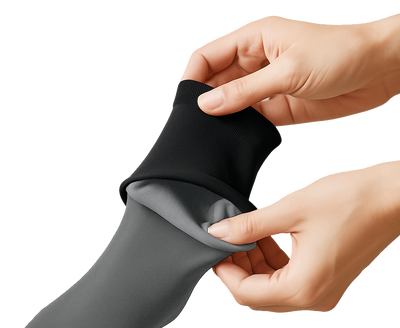What is Deep Vein Thrombosis (DVT)

DVT is a medical condition when a blood clot forms in a vein deep inside your body. A blood clot is a clump of blood turned into a solid, making average blood circulation slower. Deep vein blood clots usually form in the lower part of the legs, the calf or thigh, but can be found in other parts of your body.
Not everyone has symptoms from DVTs. People who have a blood clot in the arm don't always experience symptoms. They don't know about their condition until they've gone through emergency treatment for a pulmonary embolism (blood clot in the lungs).
The most common lower extremities DVT symptoms include:
- Cramps & sudden pain in the legs (calf or thigh)
- Swelling in the leg or ankle
- Feeling of warmness in the swollen parts of the leg
- The skin color of the affected area turning pale or reddish/bluish
The most common upper extremities DVT symptoms include:
- Shoulder & neck pain
- Swelling in the hands or arms
- Weakness in the hands
It is imperative to listen to your body and not ignore symptoms in the early phase. Making the right choices in the early phases of clot development can drastically change the potential for a poor outcome.

In normal blood flow, blood flows freely through the veins. The forming of blood clots is not unusual behavior of blood cells, preventing blood from properly circulating in the body. Clotting occurs for several reasons such as:
- The longer period of inactivity – having a sedentary job or being in a state of reduced mobility for some reason, makes your blood flow in the legs slower. This can also cause development of a blood cloth
- Medical conditions – some medical conditions and also some medicaments can make you more prone to developing a blood cloth
- Injuries & post-surgery conditions – blood vessel’s wall damage blocks the normal blood flow and that can also be the cause of cloth development
- Inherited clotting disorder, such as factor V Leiden mutation
Compression stockings are friends of your veins and legs affected by DVT in any phase and severity level of the condition.
The combination of wearing compression stocking while walking and keeping your legs elevated while sitting can do a lot for you if the vein condition is not in the advanced stage. With blood cloths, it is better to have shorter walks during the day than one long walk. While sitting and resting, it is good to keep your legs elevated.
To react timely and recognize that you suffer from DVT or related vein problems, it is good to be familiar with the risk factors that make you more prone to developing this condition. Risk factors worth noting are:
- Smoking heavily
- Not being physically active & being overweight
- Having a family history of DVT
- Having a bone fracture or some kind of injury that affects the veins
- Undergoing hormone therapy for a longer period
Although this condition is something that people live with for many years, it can impact the quality of your life and day-to-day wellbeing. And sometimes, it can even be fatal. Thus it is best to deal with it in the context of prevention by making a few, but significant lifestyle changes.

If you have a sedentary job, introduce a habit of walking before or after work. Even a walk on your lunch break will help. You can also stretch and move your legs while sitting now and then to stimulate your circulation. It is also advisable not to wear very tight clothes that can restrict the proper blood flow.
Smoking cessation, losing excess weight, and being physically active cut the risk of vein problems significantly.
If you missed the first chance to take better care of yourself, visiting the doctor should be your next step. Doctors diagnose the condition based on several analyses and the medical history of the patient. The standard tests include ultrasound, venogram, and D-dimer test. Ultrasound uses sound waves to create a picture of arteries and veins to see how blood flows through them. If there is a clotting process, the image will show interrupted blood flow, which would indicate that something is going wrong.
A venogram is an additional method for diagnosing blood clotting—This is the process of injecting dye into the vein that may have a clot. Then An X-ray is taken of the injection site. The coloring makes veins more visible, so an X-ray screening almost always shows if the cloth is present. And finally, D-dimer is a blood marker that measures the presence of a substance that's released when a blood clot breaks apart. Having an elevated D-dimer level is related to the formation and breakdown of the blood clot in the body. Elevated D Dimer is also a red flag indicating something is going on with your blood and veins.
No need to panic; knowledge of the facts is necessary for living a good and healthy life. Armed with knowledge now, consider what changes that you can implement in your life to help you stay as healthy as possible as long as possible are! Visit our shop to see more about how medical-grade compression wear from Skineez® can help you on a journey to a better and healthier life.




